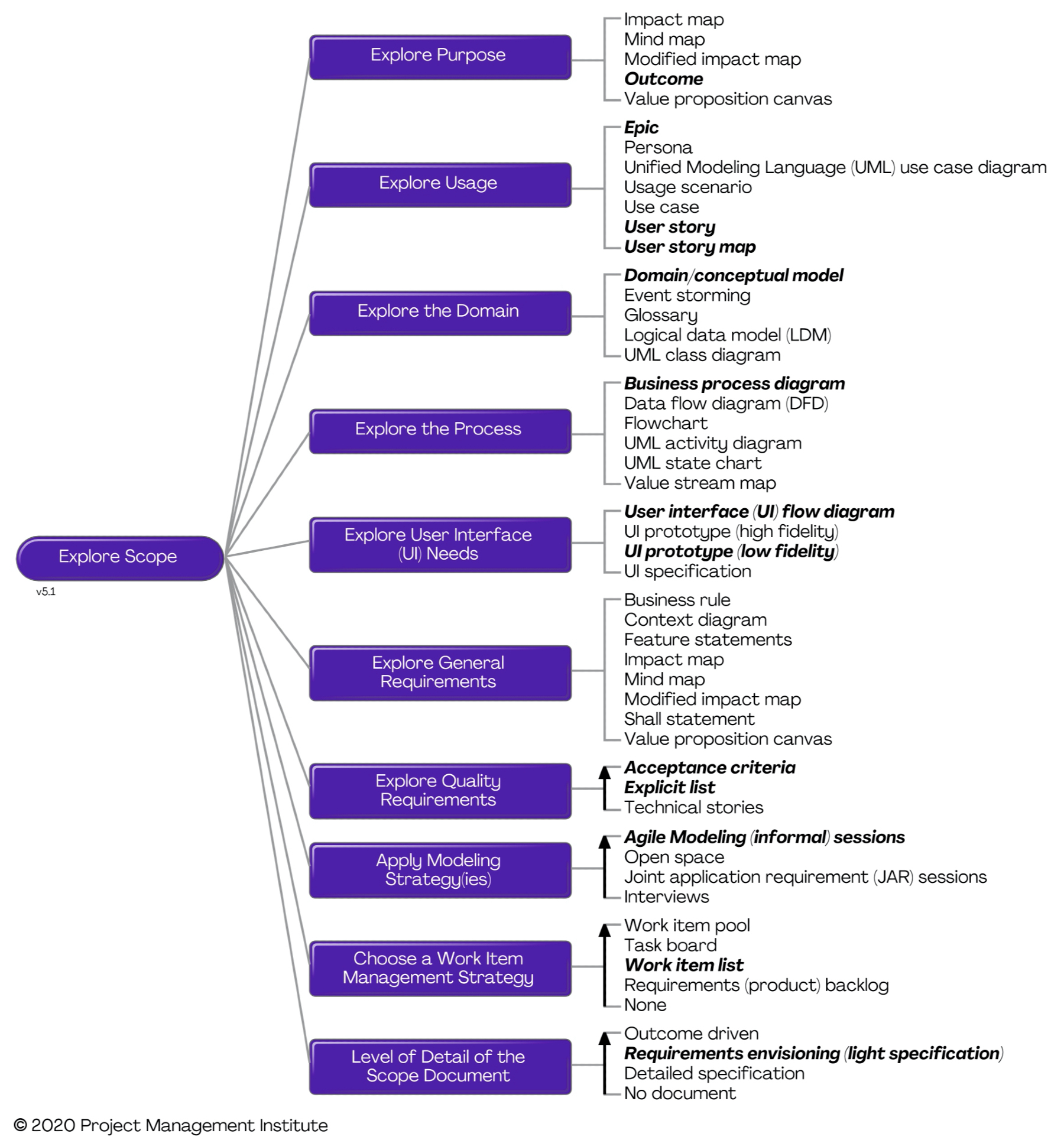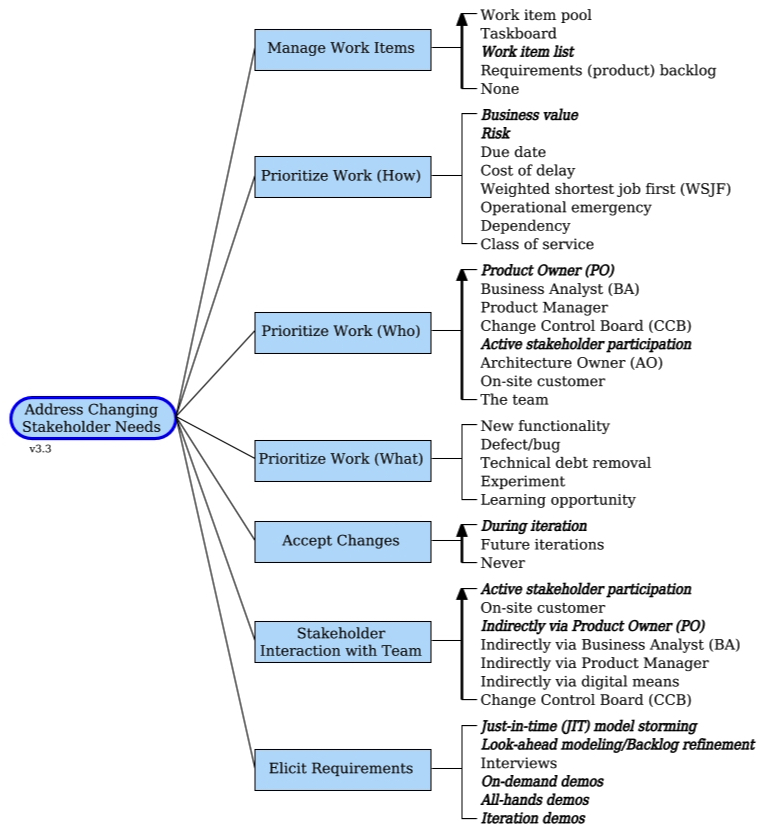
Choice is Good

First and foremost, our primary goal is to develop successful products and delight users. We are always looking for good practices to improve our odds.
Product development is a risky business.
We want to expand our toolbox with proven approaches. We use these tools to experiment when confronted with new problems. There is No Silver Bullet to solve our specific challenges.
Using a goal-driven approach that guides people through process-related options is one powerful approach. We need to take decisions to tailor and scale agile strategies to address the context of the situations we face. Approaches such as Scrum have a minimal set of instructions. You are responsible for adding the missing pieces to improve your development organization and remove your specific impediments.
What are the advantages to taking a goal-driven approach? How can you tailor your product development process?
Goals over Prescription
The Project Management Institute has acquired the disciplined agile delivery method and heavily promotes the approach. I personally prefer the LeSS approach to scale agile product development. Nevertheless, Scott Ambler is an experienced and talented developer. Learning from his experiences and analyzing his approaches promotes the essence of LeSS. We want to experiment with new approaches and add the successful ones in our toolbox.
Our philosophy is to look for great ideas regardless of their source and to recognize there are no best practices. When we learn a new technique, we strive to understand what its strengths and weaknesses are and in what situations to apply it.
The diagram shows a potential approach for scope exploration. For each facet of the exploration we have a set of methods to work with. The context of the product development and the identified goals should allow us to select the most effective approach.

-
Supports process tailoring. I think that the figures below make it very clear how people are enabled to make intelligent process decisions. I think that this is a huge improvement over previous process frameworks, particularly Rational Unified Process RUP. RUP provides great process advice regardless of what some agilists may claim but struggled to provide consumable process tailoring advice.
-
Enables effective scaling. LeSS is our preferred scaling approach. An important part of scaling agile is to tailor your strategy to reflect the realities of the scaling factors which you face. For example, consider your approach to exploring the initial scope of your effort (the goal captured in Figure 2). A large agile team or a geographically distributed team will make different tailoring decisions than a small co-located team. A team in a regulatory environment will make different decisions, particularly around the amount of detail, than teams in non-regulatory environments. These are just three of several scaling factors (more on this in a future blog posting, although you may find my agility at scale blog to be of interest).
-
Makes your process options very clear. Figure 4, in combination with the more detailed goals diagrams (such as in Figures 2 and 3) make it very clear what you need to consider when tailoring an agile solution delivery process to meet the unique needs of the situation faced by your team.
-
Takes the guesswork out of extending agile methods. Although it makes for wonderful marketing rhetoric, it’s disingenuous for people to claim that simple methods such as Scrum can be tailored to meet your actual needs. Yes, we suppose this claim is true, but how do you do so? Shouldn’t you start with a full delivery lifecycle, not just a construction lifecycle? Shouldn’t the toolkit cover a wider range of issues, such as leadership and requirement management as Scrum does, technical issues as XP does, modeling and documentation as Agile Modeling does, and many other issues? In short, shouldn’t it be a hybrid? Finally, shouldn’t you be given some context-sensitive advice for tailoring the details, as we do with the goal-driven approach described here?
-
Makes it clear what risks you’re taking on. By making your process decision options clear and by describing the trade-offs associated with those options, we make it very clear what risks you’re taking on. Want to write a detailed requirement specification up front, then the approach is going to make it very clear what risks you’ve just taken on by doing so. It also makes clear when this decision is appropriate, so if you’re not in this situation then it is likely time to rethink your approach. Although we cannot prevent challenges such as a Water-Scrum-Fall approach. Such when a heavy approach is taken to Inception and Transition and an agile approach to Construction. We still can certainly make it very clear what the impact is of the decisions that led you to that approach. We have spoken with several people who have used the decision tables in it to argue against inappropriate process decisions on their projects. In many situations the argument that isn’t agile falls on deaf ears. Whereas that will take longer and here’s why, that will be more expensive and here’s why will be listened to.
-
It hints at an agile maturity model. We suggest that in the case of issues where the options are ordered there is clearly an indication of agile maturity or sophistication. Having said that I have no desire to wade into the agile maturity model morass, but I think it is an important observation nonetheless.
Change and Adapt
Acknowledge that goals and priorities will shift during the product lifetime.

The palette of approaches for a facet of your process was exemplary shown above. You should explore solutions for all your process steps to continuously improve.